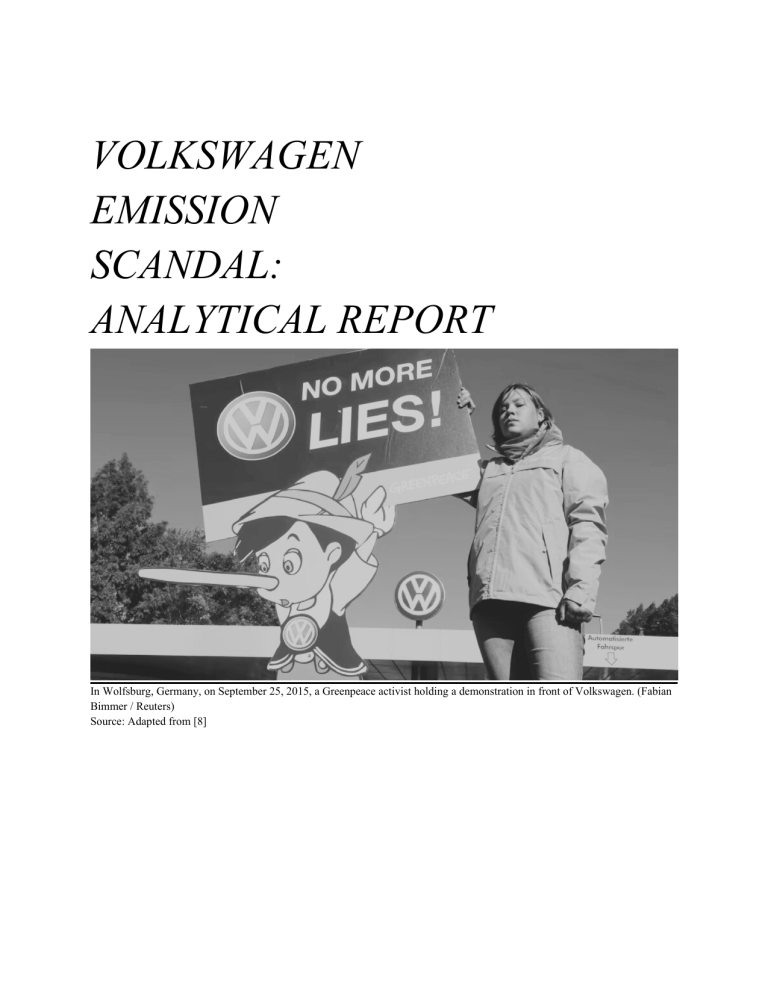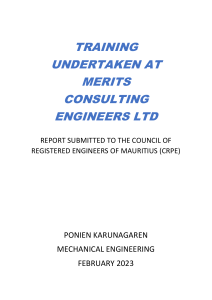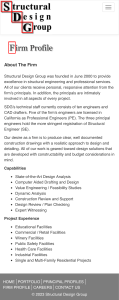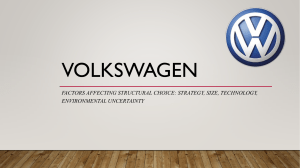
VOLKSWAGEN EMISSION SCANDAL: ANALYTICAL REPORT In Wolfsburg, Germany, on September 25, 2015, a Greenpeace activist holding a demonstration in front of Volkswagen. (Fabian Bimmer / Reuters) Source: Adapted from [8] INTRODUCTION In today’s world, protecting the environment has become a crucial aspect that businesses cannot ignore. Companies must prioritise environmental targets to ensure sustainable and smooth operations. On September 18, 2015, Volkswagen was exposed for turning a blind eye to environmental regulations. The company was caught cheating on mandatory emission tests using in-built software in their vehicles. This analytical report will focus on the Volkswagen Scandal, investigating the ethical issues, causes, and consequences after and during the company’s deceptive practices. BACKGROUND From 2009–2015, the engineers at Volkswagen implemented a software known as a “defeat device” in their diesel cars [1]. This software could change the vehicle’s performance according to the type of scenario the vehicle was put under. Under test conditions, the software activates, worsening the car’s performance while improving the vehicle’s emission levels (drastic reduction in nitrogen oxide emissions [2]). This helped the company navigate their vehicles through tough environmental regulations put forth by different countries. It was confirmed [2] that over 11 million cars worldwide were fitted with this device. These cars include popular models such as VW Golf, VW Beetle, and Audi A3. The company was finally exposed by the Environmental Protection Agency (EPA) and faced severe public backlash. This led to a sharp decline in stock prices, resulting in a €15 billion plummet in share prices [3]. The CEO of VW, Martin Winterkorn, responded to the allegations with an apology and even claimed to be “unaware” of the installation of the “defeat device”[2], but the damage had been done and the company’s reputation had been jeopardised. CAUSES AND ETHICAL IMPLICATIONS The three main causes of the VW scandal are organisational, technical, and structural. Under organisational causes, issues arose from the corporate culture established within the company. Between 2007 and 2015, CEO Martin Winterkorn was known for being intense and “demanding” [4]. His aspirations were to bring VW up the ranks and ensure VW became the biggest car manufacturer in the world [4]. With such ambitious goals, the company strived for perfection, putting immense pressure on the engineers. These engineers struggled to manufacture cars that could meet the same standards as competitors with regards to durability, fuel economy, performance, and emissions [5]. In order to surpass competitors, the engineers were forced to resort to the “defeat device”. This is a clear violation of rules 1.1, 1.4, and 3.4 of the HKIE rules of conduct because the engineers act disingenuously by compromising the integrity of the profession and the protection of the environment. However, engineers cannot be entirely blamed. According to a former VW executive [4], the company had established an authoritarian leadership. This style of leadership forces engineers to follow orders set by individuals in higher positions blindly. This made it difficult for engineers in VW to voice out their professional opinions, which led them to disregard rule 1.3 of the HKIE rule of conduct by not providing their professional insights. One former executive even goes on to say, “If you didn’t like it, you moved of your own accord or you were performance-managed out of the business”. This highlights how VW strong-armed their engineers into following all instructions put forth by managers. With regards to technical causes, doubts had risen regarding the technical capabilities of the engineers in the company. According to Marc Tarahan, a retired vice president at VW and a supporter of Martin Winterkorn [4], he believed that the CEO and management board were oblivious to the “defeat device” and even stated that “There is no way they would have allowed this to continue if they had known that U.S. laws were being broken”. This would imply that engineers discretely designed the “defeat device” by themselves, which highlights the fact that they lacked the skills the job required. This is a violation of rules 1.7 and 3.1 of the HKIE rule of conduct because the engineers take up a task that they are not qualified to fulfil with integrity while also safeguarding information from their employers. This view would place the entirety of the blame on the engineers. In terms of the structure of the company, VW consists of a management board that oversees the company’s operations and a supervisory board that has control over the CEO and possesses the authority to dismiss members of the management board [4]. Within this supervisory board, labour holds more than half of the position, meaning the majority of control lies in the hands of the union. The union’s main objective is to ensure that jobs are protected and provided [4] [6]. Martin Winterkorn used this to his advantage by ensuring this objective was met. This allowed him to have full control of the company, instilling his own beliefs and mindset down the chain of command. As mentioned earlier, Martin Winterkorn was known for being “demanding” [4] and wanting VW to become a powerhouse in the car industry despite the ethical implications it may have (in 2014, VW faced scrutiny for installing defective airbags in the VW Beetle [7]). This idea of not prioritising “ethics” may have passed down the hierarchy, leading to some engineers not valuing its importance, resulting in the engineers developing the “defeat device”. CONCLUSION In summary, the Volkswagen Scandal of 2015 shows how a toxic mix of corporate culture, authoritarian leadership, and technical inadequacies can lead to a serious ethical lapse. The relentless pursuit of corporate success pressured engineers into compromising their professionalism by using the "defeat device" to meet emissions standards. Doubts about their technical competence further worsened the situation, revealing a lack of both skill and ethics. In my opinion, this serves as a vital reminder for companies to prioritise ethics and environmental sustainability to build trust and long-term success. REFERENCE LIST [1] "Learn About Volkswagen Violations." U.S. Environmental Protection Agency. [Online]. Available: https://www.epa.gov/vw/learn-about-volkswagen-violations. [Accessed: October 8, 2023]. [2] R. Hotten, "Volkswagen: The scandal explained," BBC News, 10-Dec-2015. [Online]. Available: https://www.bbc.com/news/business-34324772. [Accessed: October 8, 2023]. [3] J. Kollewe, "Volkswagen emissions scandal - timeline," The Guardian, 10-Dec2015. [Online]. Available: https://www.theguardian.com/business/2015/dec/10/volkswagen-emissionsscandal-timeline-events. [Accessed: 8th October 2023]. [4] "Emissions scandal: VW's demanding culture under Winterkorn led to crisis," CNBC, Oct. 11, 2015. [Online]. Available: https://www.cnbc.com/2015/10/11/emissions-scandal-vws-demanding-cultureunder-winterkorn-led-to-crisis.html. [Accessed: 8th October 2023]. [5] "Case2.mp4," streaming.cle.ust.hk, 2019. [Online]. Available: http://streaming.cle.ust.hk/media/courses/lang2030/2019_spring/case2.mp4. [Accessed: 8th October 2023]. [6] J. Ewing and G. Bowley, "The Engineering of Volkswagen’s Aggressive Ambition," *The New York Times*, Dec. 13, 2015. [Online]. Available: https://www.nytimes.com/2015/12/14/business/the-engineering-of-volkswagensaggressive-ambition.html. [Accessed: 8th October 2023]. [7] "VW recalls 680,000 brand cars in US over airbag problems," CNBC, Feb. 10, 2016. [Online]. Available: https://www.cnbc.com/amp/2016/02/10/vw-recalls680000-brand-cars-in-us-over-airbag-problems.html. [Accessed: 8th October 2023]. [8]B. Lam, "The Academic Paper That Broke the Volkswagen Scandal," The Atlantic, Sep. 2015. [Online]. Available: https://www.theatlantic.com/business/archive/2015/09/volkswagen-scandal-cheatingemission-virginia-epa/407425/. [Accessed: 8th October, 2023].




![Question 1 [ ] 1- What is the main goal for software engineering](http://s2.studylib.net/store/data/010210498_1-4a6ecbb9be365dadeadd769b25d4af75-300x300.png)
